State Of The Beaches Report: 2019-2020
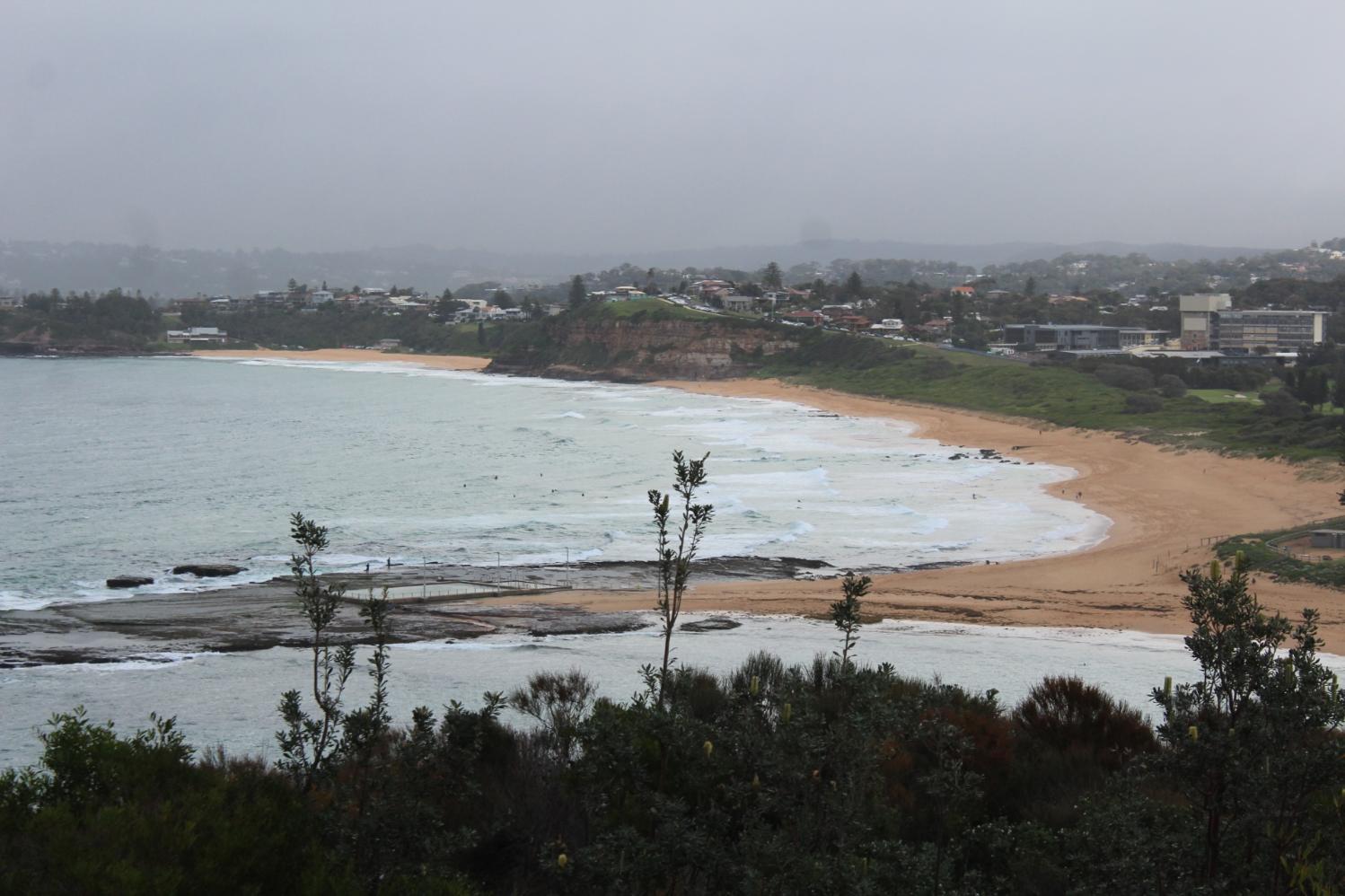
The 2019-2020 State of the Beaches report was released on Thursday October 29, 2020 with the Sydney Beaches area chapter showing a great shot of Avalon Beach as its cover this year.
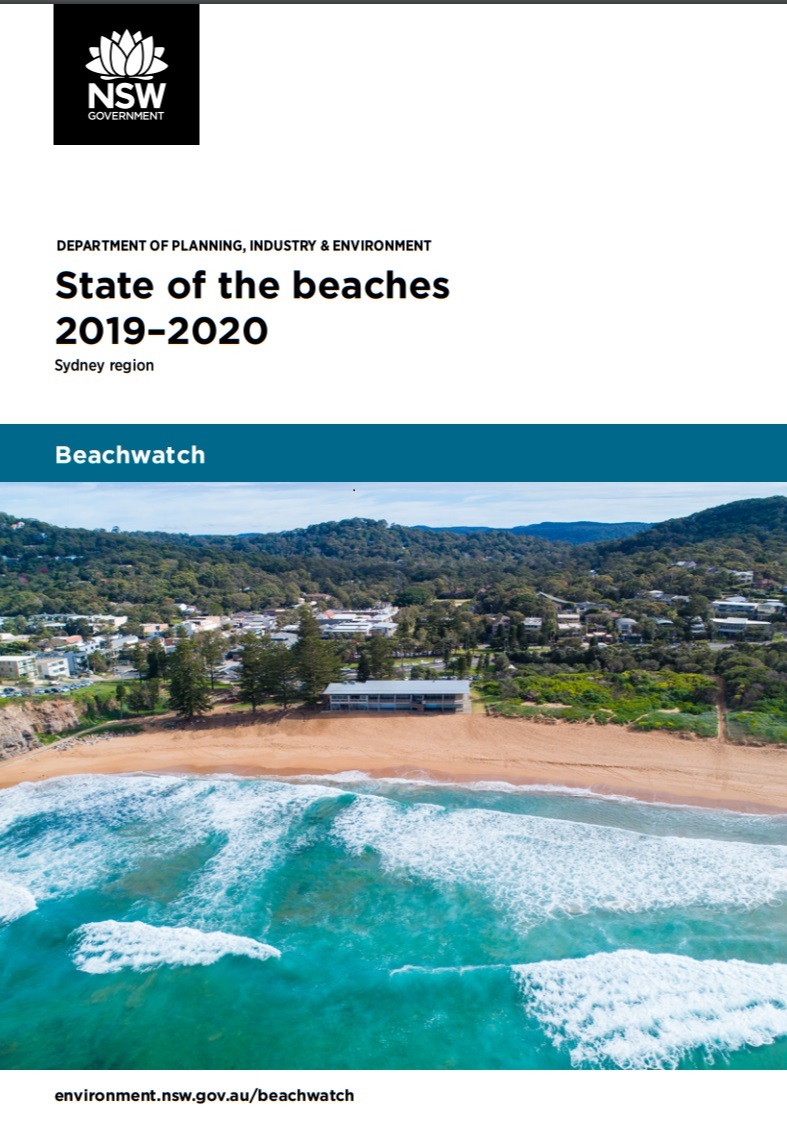 In the Pittwater to Manly area All 32 swimming sites were graded as Very Good or Good in 2019–2020. The best beaches were Palm Beach, Whale Beach, Avalon Beach, Bilgola Beach, Newport Beach, Bungan Beach, Dee Why Beach, South Curl Curl Beach, Elvina Bay, The Basin and Great Mackerel Beach. These sites had excellent water quality and were suitable for swimming almost all of the time.
In the Pittwater to Manly area All 32 swimming sites were graded as Very Good or Good in 2019–2020. The best beaches were Palm Beach, Whale Beach, Avalon Beach, Bilgola Beach, Newport Beach, Bungan Beach, Dee Why Beach, South Curl Curl Beach, Elvina Bay, The Basin and Great Mackerel Beach. These sites had excellent water quality and were suitable for swimming almost all of the time.
Mona Vale, Warriewood, Turimetta, North Narrabeen, Collaroy, Long Reef, North Curl Curl, Freshwater, Queenscliff, North Steyne, South Steyne and Shelly beaches were graded as Good. Mona Vale and Shelly beaches were downgraded to Good from Very Good in 2018–2019.
Estuarine and lagoon swimming sites did not perform as well as ocean beaches due to lower levels of flushing, which increase the time needed to disperse and dilute pollution inputs, taking longer to recover from stormwater events.
While Bayview Baths and Barrenjoey Beach have been graded Good for the last three years, elevated enterococci levels were occasionally recorded during dry weather conditions.
The NSW National Parks and Wildlife Service has decommissioned septic systems and installed a number of sewer pumping stations to service Barrenjoey Head, located at the northern end of Barrenjoey Beach. The lighthouse and Fisherman’s Cottages were decommissioned in July 2016, and Boatman’s Cottage in November 2016. Final connection of the Barrenjoey Head sewer system to the Sydney Water sewerage network was completed in December 2019.
The two sites in Narrabeen Lagoon, Birdwood Park and Bilarong Reserve, were graded Good. Bilarong Reserve improved to Good from a Poor grade in 2018–2019. Water quality at these sites was mostly suitable for swimming during dry weather, with elevated enterococci levels recorded following rainfall.
Birdwood Park in Narrabeen Lagoon has been graded as Good for the last three years. While microbial water quality was occasionally elevated during dry weather, it was generally of good standard with 86% of samples suitable for swimming when there had be no rain in the previous 24 hours. Enterococci levels increased with increasing rainfall, and often exceeded the safe swimming limit after light rainfall. Birdwood Park is located at the entrance to the lagoon and water quality at this site is influenced by wet weather events and whether the lagoon is open to the ocean. Discharge from Narrabeen Lagoon is a significant source of faecal contamination.
Bilarong Reserve in Narrabeen Lagoon improved to Good from a Poor grade in 2018–2019. The microbial water quality at this site improved slightly from the previous year and remains close to the threshold between Good and Poor, with the site fluctuating several times between the grades over the past several years. During dry weather, enterococci levels occasionally exceeded the safe swimming limit, and were regularly unsuitable for swimming after light to moderate rainfall. The swimming site retains pollution inputs because it is located away from the lagoon entrance and is not well flushed by clean ocean water. A significant source of faecal contamination is stormwater runoff to the lagoon.
Water quality at Birdwood Park and Bilarong Reserve lagoon sites has improved slightly from the previous year. During the assessment period, Narrabeen Lagoon has closed naturally for extended periods and been mechanically opened by council on several occasions. While the entrance to the lagoon remains closed, water quality is likely to decline as pollution inputs are not as readily dissipated or flushed.
Between September and December 2018, council undertook large scale clearance works which kept the lagoon entrance open until October 2019 before it closed naturally. The lagoon entrance remained closed until it was mechanically opened during a storm in February 2020.
Two major sediment removal projects took place in 2018–2019, removing thousands of tonnes of sediment from Burnt Bridge Creek, which feeds into Manly Lagoon and Queenscliff Beach, and at South Creek, which leads to Narrabeen Lagoon. Removal of excess sediment is important, as high sediment loads can cloud waterways, affecting vegetation and fish health. Sediment can also carry pollutants such as faecal bacteria, toxins and nutrients that encourage algal growth.
During 2019 and 2020, Sydney Water, Council and Beachwatch officers collected samples at Manly and Narrabeen lagoon entrances for genetic analysis. It is anticipated the genetic analysis, to be undertaken by the University of Newcastle in 2020–2021, will shed light on possible contributors to faecal contamination at these popular sites.
Council and Sydney Water collaborated in 2016–2017 to assess dry and wet weather stormwater quality around Bayview Baths, Bayview. The area was found to be impacted by diffuse stormwater pollution, and therefore swimming at Bayview Baths should be avoided for at least three days after heavy rain.
Water sensitive urban design has been implemented across the local government area and particularly in the Warriewood land release area, where it improves water quality prior to discharge into Narrabeen Lagoon.
As a general precaution swimming should be avoided during and for at least one day after heavy rain at ocean beaches, and for up to three days in estuarine and lagoon areas, or if there are signs of stormwater pollution such as discoloured water or floating debris.
Environment Minister Matt Kean said 89% of the 228 swimming sites monitored across the State were graded as 'Very Good' or 'Good' in the latest report.
"We haven't had beaches this clean since the Beachwatch program started in 1989," Mr Kean said.
"While water quality results can vary year-on-year, based largely on the amount of rainfall we receive, this is great news for locals and visitors alike.
"As we head into the swimming season I encourage everyone to not only Slip, Slop and Slap and swim between the flags, but to be COVID Safe on our beaches this summer."
Open ocean beaches across the State recorded excellent results with 98% of the 126 monitored, including the iconic Bondi and Manly, graded as 'Very Good' or 'Good'.
Improvements were also recorded at estuarine beaches, lakes and lagoons across the state with 85% of estuarine swimming sites and 42% of lakes and lagoons graded as 'Very Good' or 'Good'.
Water quality at five swimming sites was downgraded compared to last year, including at Swansea Heads Little Beach in the Hunter and Hayes St Beach in Sydney.
The State of the Beaches report provides an overview of the water quality at 228 swimming locations monitored under the Beachwatch and Beachwatch Partnership programs across New South Wales.
In Sydney 92% of swimming sites in the Sydney region were graded as Good or Very Good – a 2% improvement on last year. Water quality improved at 5 estuarine beaches and lagoon swimming sites, while a decline was recorded at four ocean and estuarine beaches.
Station Beach (Barrenjoey Beach) shows an animal related faeces pollution; ''Enterococci levels increased slightly with increasing rainfall, occasionally exceeding the safe swimming limit after little or no rain, and regularly after 20 mm or more.''
As none of the small crowds of a mix of shorebirds have been witnessed at the beach since the commencement of the '12 month on-leash dog trail', with dogs also running off-leash right along the beach and throughout Governor Phillip Park, and residents recording up to 170 dogs off-leash on the beach on one recent Sunday, and not one of the mitigation measures listed in the REF released after consultation as yet installed, 10 months on, the 'exceeding the safe swimming limit after little or no rain' levels of Enterococci levels to April 2020, the period of counts for this report, cannot be attributed to bird droppings this year and foreshadows what may be in next years' 'State of the Beach' at this estuarine swimming spot, adjacent to a National Park. This year's report shows The Basin, where dogs cannot chase birds and other wildlife from their homes, also has animals present, but no where near that recorded at Barrenjoey/Station Beach.
Although all of the Pittwater estuary swimming spots show susceptibility to Enterococci levels, Station Beach (Barrenjoey Beach) is the only one showing contamination due to animals, at a level comparative with pollution that streams out of the Hawkesbury River after storm events. Bayview Baths, just around the tidal corner from where dogs may swim at Rowland Reserve, also shows animal contamination but at a miniscule level compared to Barrenjoey/Station Beach. Even Curl Curl Lagoon, where dogs are allowed to swim at at the northern part of the beach at Carrington Parade, is below the level of faecal matter attributed to animals on Barrenjoey Beach. Barrenjoey is now Pittwater's most polluted most often estuarine beach and the most polluted due to 'animals' along the whole of the peninsula according to the 2019-2020 State of Beaches report. The same report records National Parks and Wildlife having finished installing a sewerage network at Barrenjoey Lighthouse in December 2019.
Further south on the Pittwater estuary Elvina Bay has gone from Good to Very Good showing an improvement of water quality with onsite sewerage systems, stormwater and boats being the prime makers of pollution.
The 2019-2020 NSW Government State of the Beaches report says that;
Contamination of recreational waters with faecal material from animal and human sources can pose significant health problems to beach users owing to the presence of pathogens (disease-causing microorganisms) in the faecal material. The most common groups of pathogens found in recreational waters are bacteria, protozoans and viruses.
Exposure to contaminated water can cause gastroenteritis, with symptoms including vomiting, diarrhoea, stomach-ache, nausea, headache and fever.
Eye, ear, skin and upper respiratory tract infections can also be contracted when pathogens come into contact with small breaks and tears in the skin or ruptures of the delicate membranes in the ear or nose.
Certain groups of users may be more vulnerable to microbial infection than others. Children, the elderly, people with compromised immune systems, tourists, and people from culturally and linguistically diverse backgrounds are generally most at risk.
The water quality of beaches and other swimming locations is monitored under the NSW Government’s Beachwatch programs to provide the community with accurate information on the cleanliness of the water and to enable individuals to make informed decisions about where and when to swim. Routine assessment also measures the impact of pollution sources, enables the effectiveness of stormwater and wastewater management practices to be assessed and highlights areas where further work is needed.
Swimming sites in New South Wales are graded as Very Good, Good, Fair, Poor or Very Poor in accordance with the National Health and Medical Research Council’s 2008 Guidelines for Managing Risks in Recreational Waters. These Beach Suitability Grades provide a long-term assessment of how suitable a beach is for swimming. The grades are determined from the most recent 100 water quality results (two to four years’ worth of data depending on the sampling frequency) and a risk assessment of potential pollution sources.
Rainfall is the major driver of pollution to recreational waters, generating stormwater runoff and triggering untreated discharges from the wastewater treatment and transport systems. Changes in rainfall patterns are reflected in beach water quality over time due to variation in the frequency and extent of stormwater and wastewater inputs.
The Beach Suitability Grades for 2019–2020 are based on water quality data collected over the last two to four years. The 2019-2020 State of the Beaches report records that rainfall over this period has been diverse:
- 2016–2017: the wettest March on record for many coastal areas and intense storm activity over summer
- 2017–2018: prolonged dry weather periods broken by heavy rain at times
- 2018–2019: variable rainfall, with a mix of extended dry weather periods and some very wet months
- 2019–2020: average to below average rainfall, except for some isolated wet weather events and wet February.
Sydney’s total rainfall in winter 2019 was slightly below the long-term average in the city and south, and slightly above the long-term average in the north. While moderate to heavy rain events occurred several times in June 2019 and late in August 2019, July 2019 was very dry, with most sites recording less than half of their long-term monthly totals.
The Sydney region received average to above average rainfall totals in September 2019, but with most of the rain falling over three days in the middle of the month. Avalon Beach recorded its highest September daily rainfall on record with 96 mm falling on the 18th.
Very dry conditions followed for the remainder of spring and early summer with well below average rainfall recorded from October 2019 to January 2020. December 2019 was significantly dry, with Sydney and Mona Vale recording their lowest December rainfall total on record with 2 mm and 1 mm respectively for the month, and Randwick recording its lowest December total rainfall since 1979, with 9 mm for the month.
Despite the dry December 2019 and January 2020, Sydney had its wettest summer since 1991–1992 due to very heavy rainfall in early February 2020. Monthly rainfall totals for February 2020 were more than three times the long-term monthly averages, with 442 mm at Sydney and 303 mm at Sans Souci. The severe wet weather led to flooding across Sydney as well as coastal erosion at some beaches.
Beachwatch issued extreme wet weather alerts on all Sydney daily beach pollution forecasts during February 2020, advising stormwater pollution may be impacting ocean beaches for an extended period, with lifeguard reports of floating debris and discoloured water continuing after the rain had ceased.
Sydney experienced many isolated showers during March 2020, with 21 days recording rainfall. April 2020 was dry with well below average rainfall totals recorded for the month.
Water NSW reported several occurrences of marine algal blooms at Sydney beaches in 2019–2020. Algal blooms of the genus Trichodesmium were reported at Balmoral and Edwards beaches in Sydney Harbour in May 2019 and occurred in the harbours and at ocean beaches in February 2020 - residents also saw these at Palm Beach. Marine algae advisories were issued on the Beachwatch and Water NSW websites.
The appearance of marine algae is sometimes mistaken for sewage contamination or oil slicks, due to a strong odour and red or brown discolouration in the water caused by the blooms. As a precaution, direct contact with algae should be avoided as it can cause skin and eye irritations. The marine algal blooms dissipated with changes in tide and wind conditions.
Beachwatch issues daily beach pollution forecasts to enable beach goers to make informed decisions about where and when to swim. Pollution forecasts for the Sydney region can be accessed via the Beachwatch website, email subscription, Twitter and Facebook
The details from this year's State of Beaches Report for our area run below.
The Details
Pittwater Estuarine Swimming Spots
Barrenjoey Beach (Station Beach)
Barrenjoey Beach is approximately 1.5 kilometres long and located on the north-eastern foreshore of Pittwater.
The Beach Suitability Grade of Good indicates microbial water quality is considered suitable for swimming most of the time but may be susceptible to pollution after rain, with several potential sources of faecal contamination.
Enterococci levels increased slightly with increasing rainfall, occasionally exceeding the safe swimming limit after little or no rain, and regularly after 20 mm or more.
The site has been monitored since 1996.
Assessment period Dry weather samples suitable for swimming Water samples Beach grade status
Nov 2017 to Apr 2020 87% 100 Stable
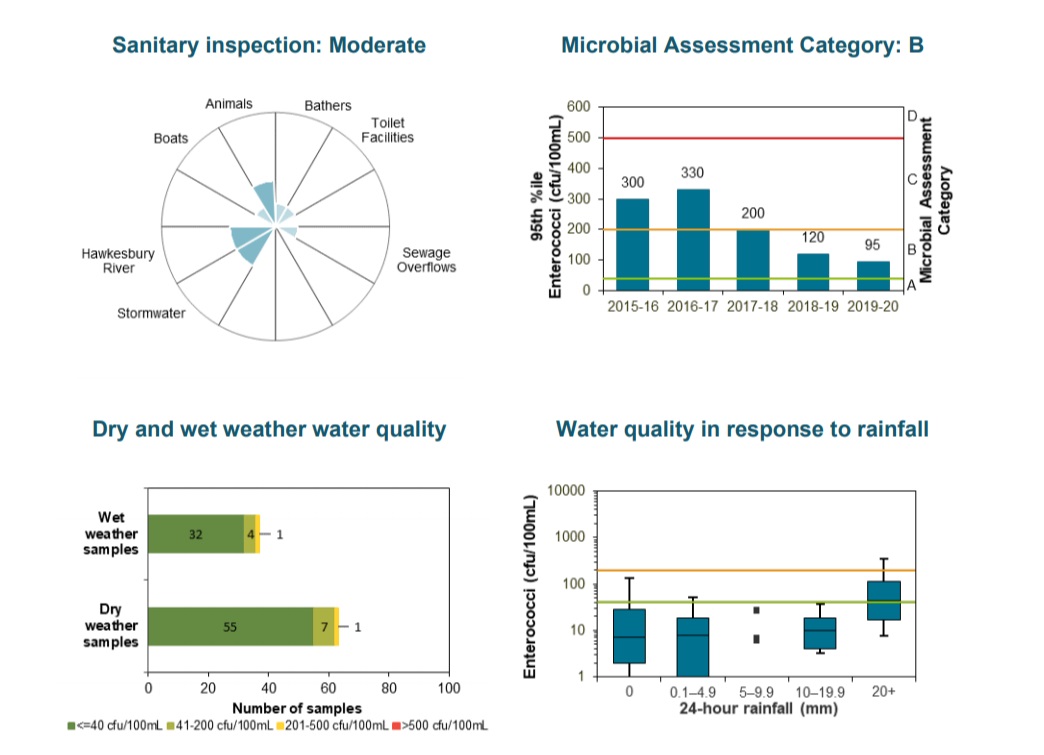
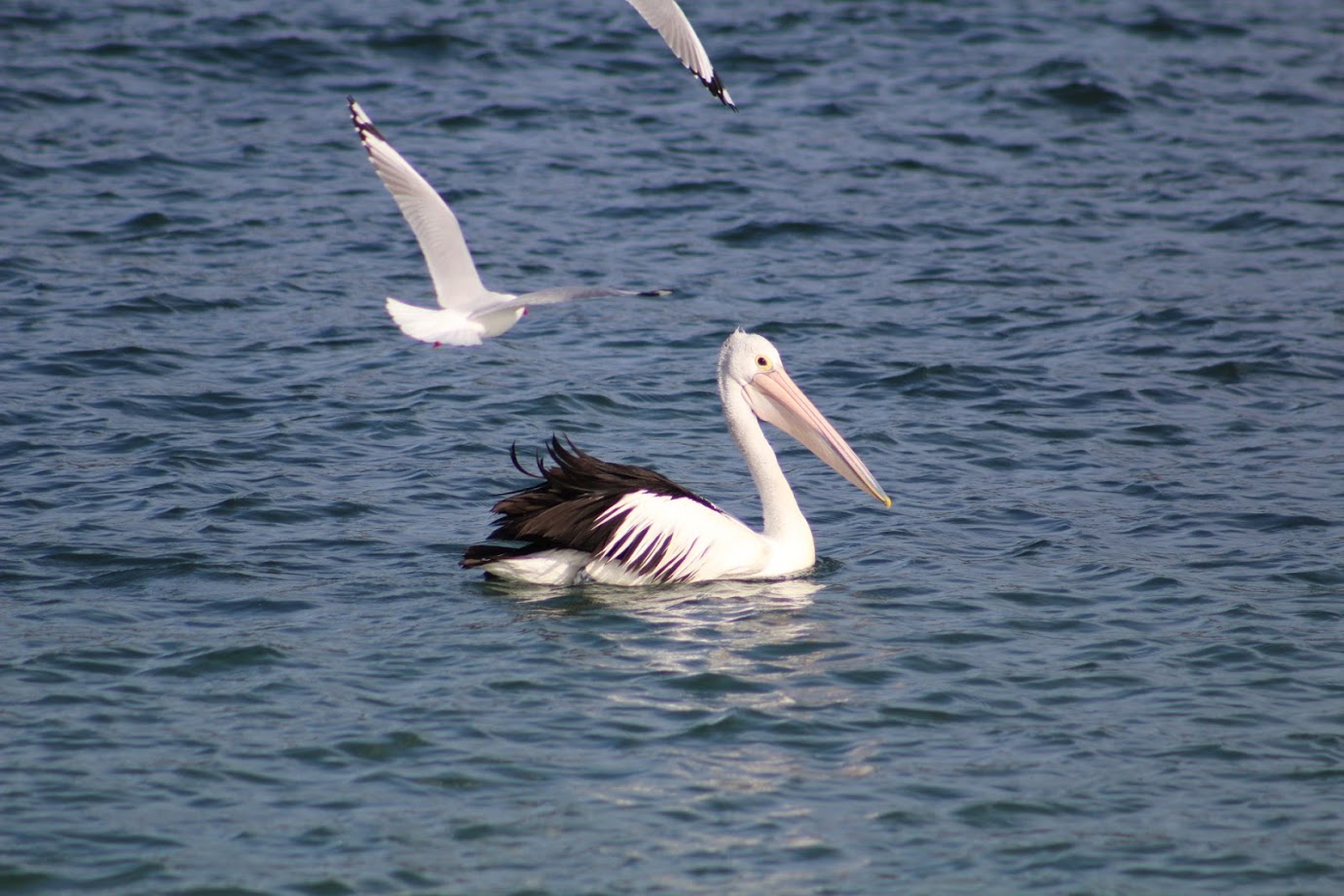
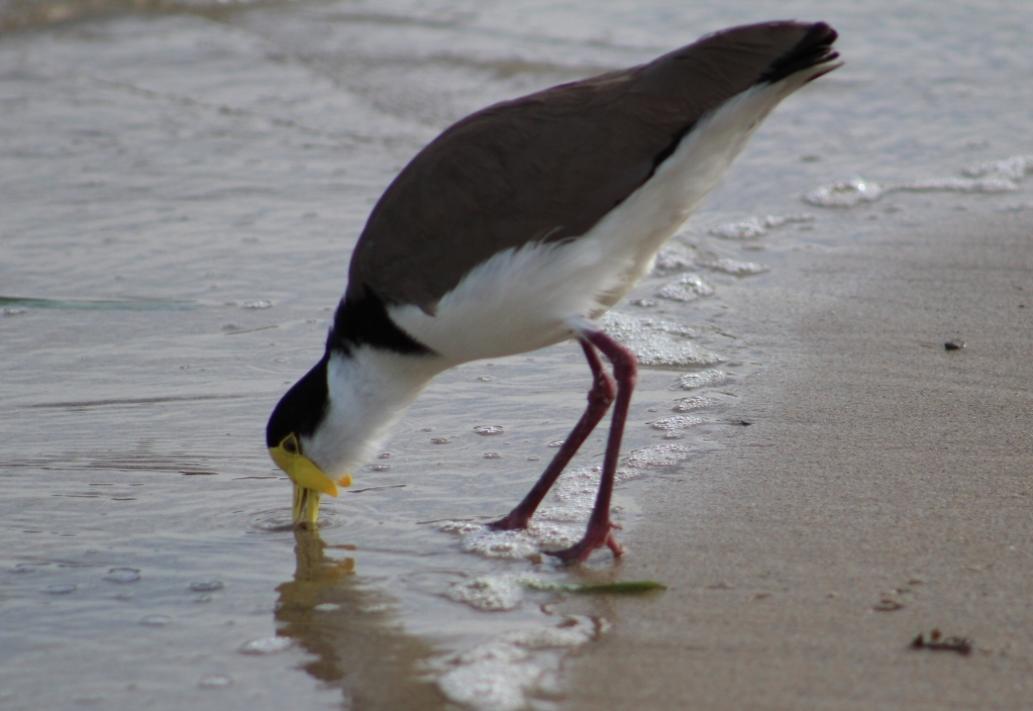
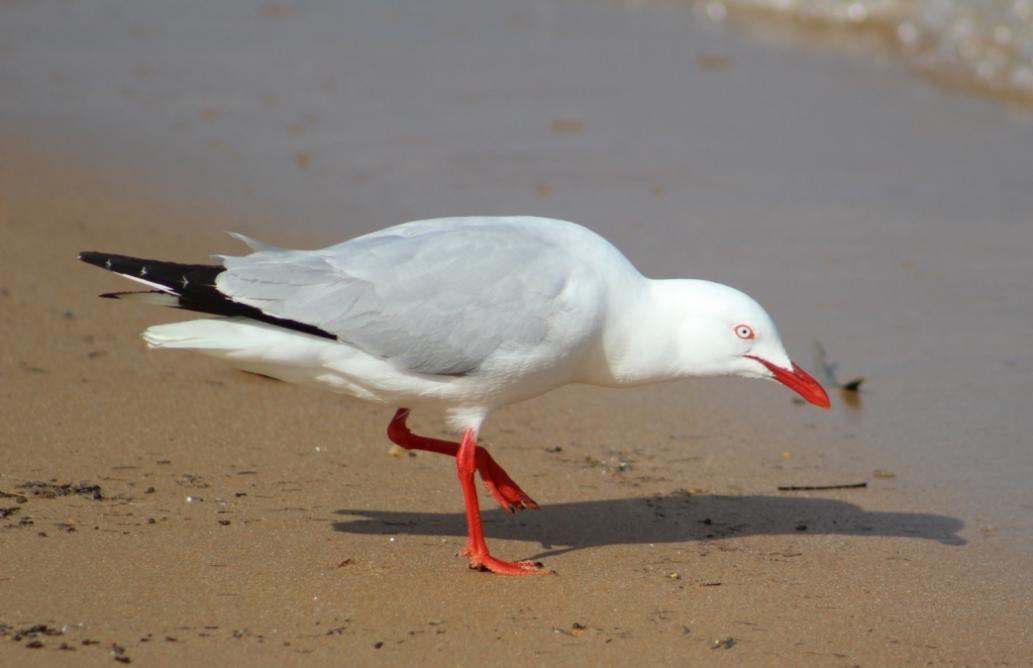
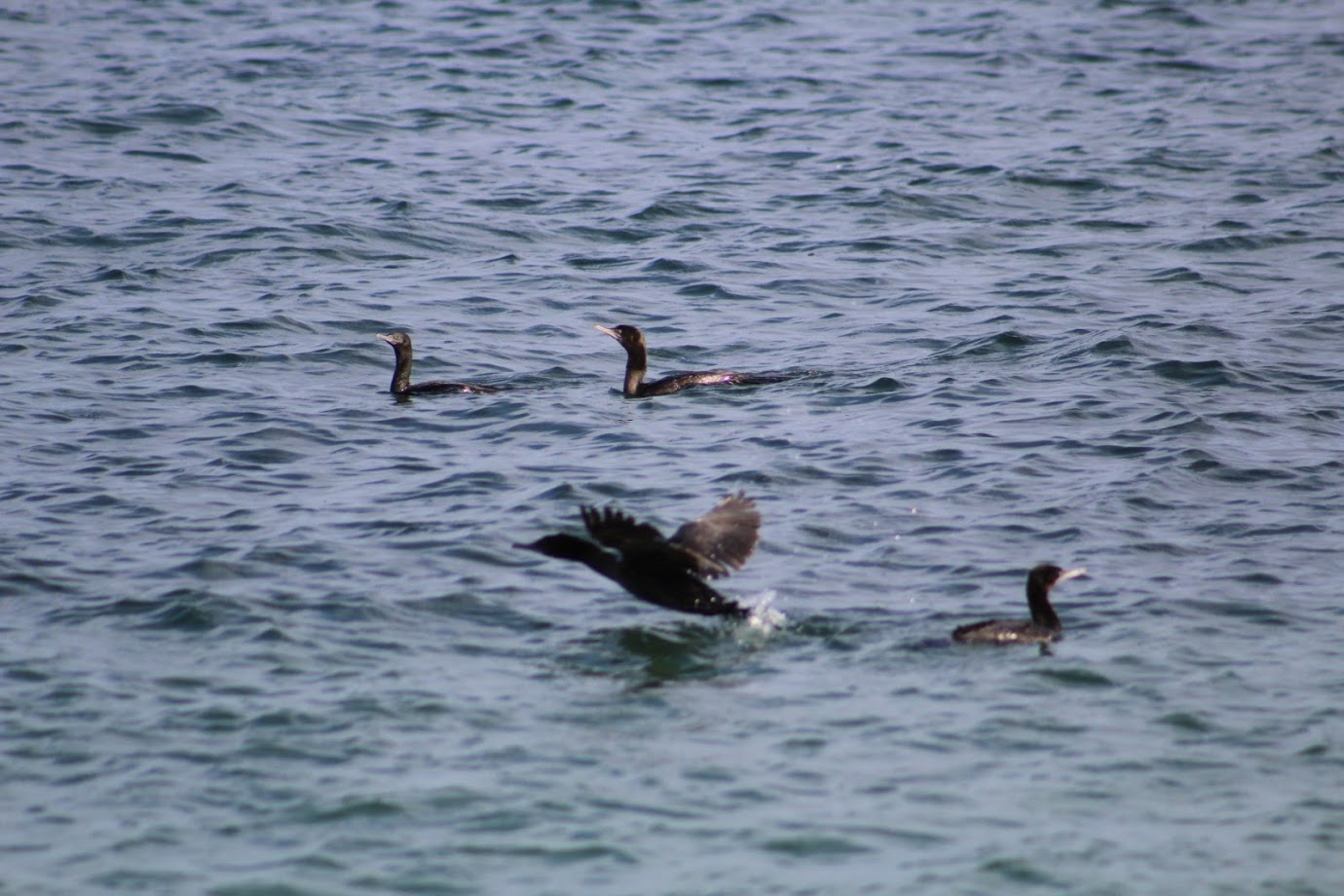
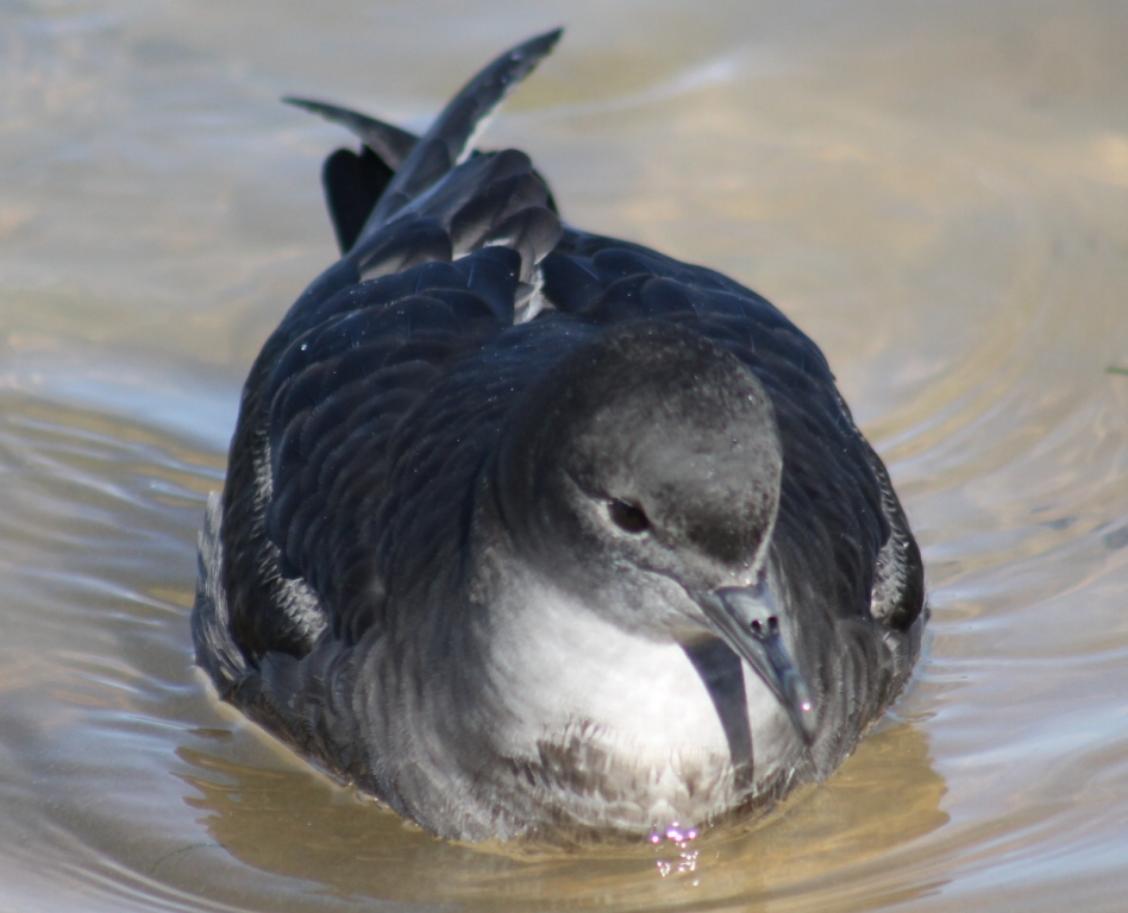
Paradise Beach Baths
Paradise Beach Baths is a 30 by 20 metre netted swimming enclosure on the eastern foreshore of Pittwater.
The Beach Suitability Grade of Good indicates microbial water quality is considered suitable for swimming most of the time but may be susceptible to pollution after rain, with several potential sources of faecal contamination including stormwater.
Enterococci levels increased with increasing rainfall, occasionally exceeding the safe swimming limit in response to light rain, and often after 10 mm or more.
The site has been monitored since 1996
Assessment period Dry weather samples suitable for swimming Water samples Beach grade status
Nov 2017 to Apr 2020 98% 100 Stable
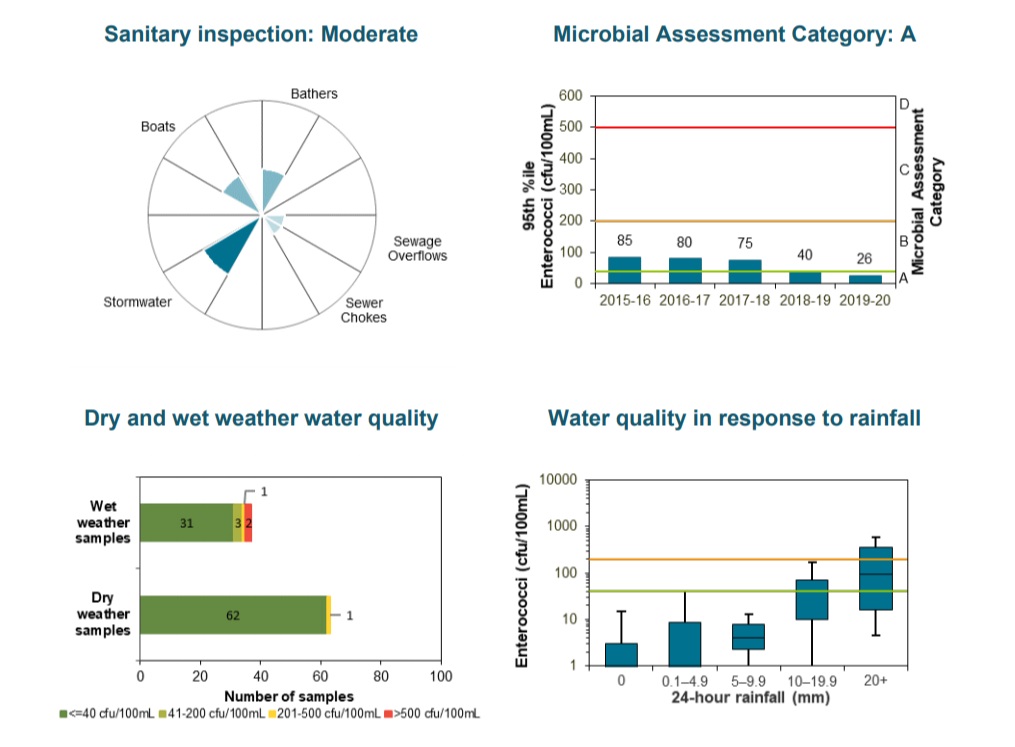
Clareville Beach
Clareville Beach is a narrow 250 metre long beach located on the eastern foreshore of Pittwater.
The Beach Suitability Grade of Good indicates microbial water quality is considered suitable for swimming most of the time but may be susceptible to pollution after rain, with several potential sources of faecal contamination including stormwater.
Enterococci levels generally increased with increasing rainfall, occasionally exceeding the safe swimming limit after 5 mm or more of rain, and regularly after 20 mm or more.
The site has been monitored since 1995.
Assessment period Dry weather samples suitable for swimming Water samples Beach grade status
Nov 2017 to Apr 2020 100% 100 Stable
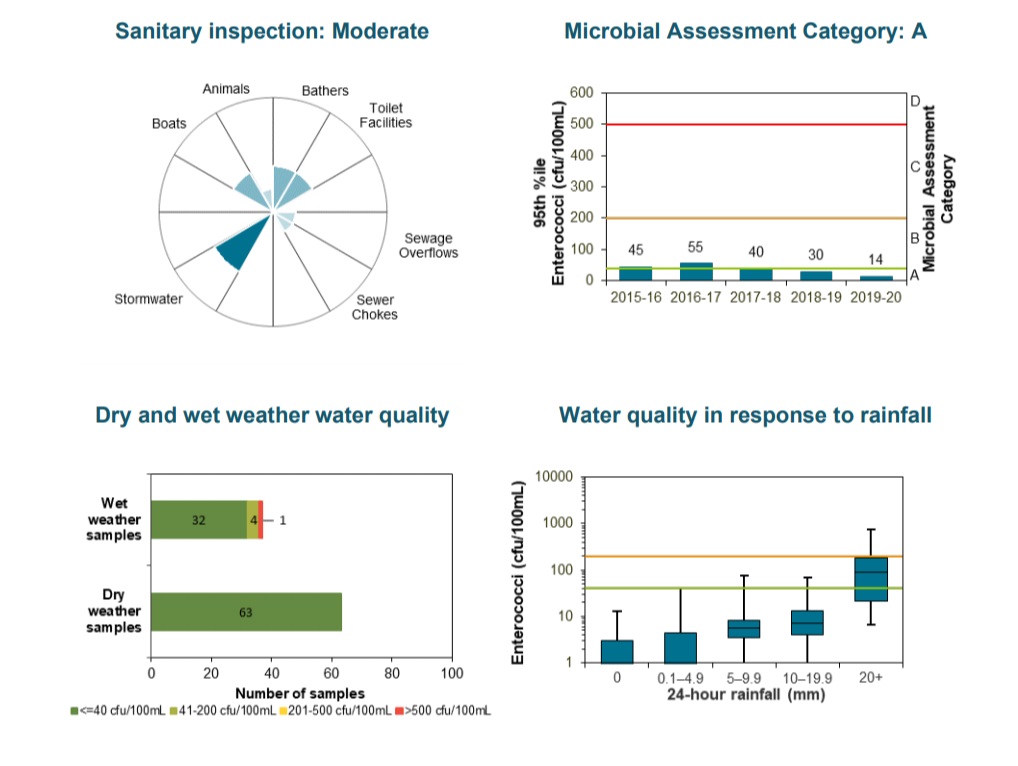
Taylors Point Baths
Taylors Point Baths is a 15 by 20 metre netted swimming enclosure on the eastern foreshore of Pittwater.
The Beach Suitability Grade of Good indicates microbial water quality is considered suitable for swimming most of the time but may be susceptible to pollution after rain, with several potential sources of faecal contamination including stormwater.
Enterococci levels generally increased with increasing rainfall, occasionally exceeding the safe swimming limit after 5 mm or more of rain, and regularly after 20 mm or more.
The site has been monitored since 2010.
Assessment period Dry weather samples suitable for swimming Water samples Beach grade status
Nov 2017 to Apr 2020 100% 100 Stable
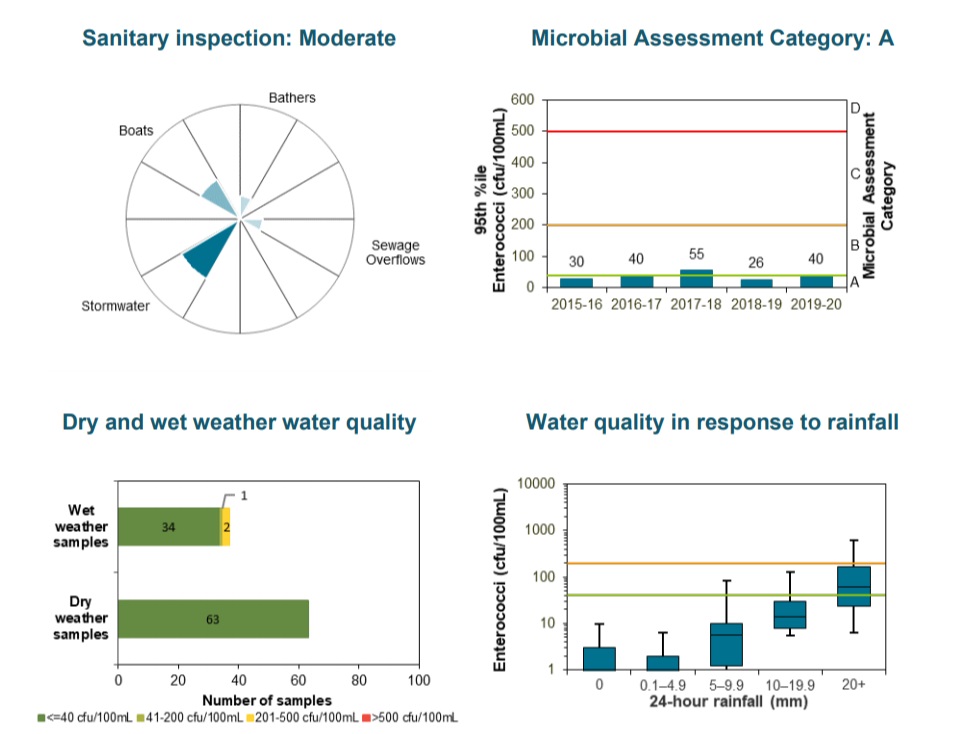
Bayview Baths
Bayview Baths is a 20 by 40 metre swimming enclosure on the southern foreshore of Pittwater.
The Beach Suitability Grade of Good indicates microbial water quality is considered suitable for swimming most of the time but may be susceptible to pollution after rain, with several potential sources of faecal contamination including stormwater and sewage overflows.
Enterococci levels generally increased with increasing rainfall, occasionally exceeding the safe swimming limit after little or no rain, and usually after 20 mm or more.
The site has been monitored since 1995.
Assessment period Dry weather samples suitable for swimming Water samples Beach grade status
Nov 2017 to Apr 2020 90% 100 Stable
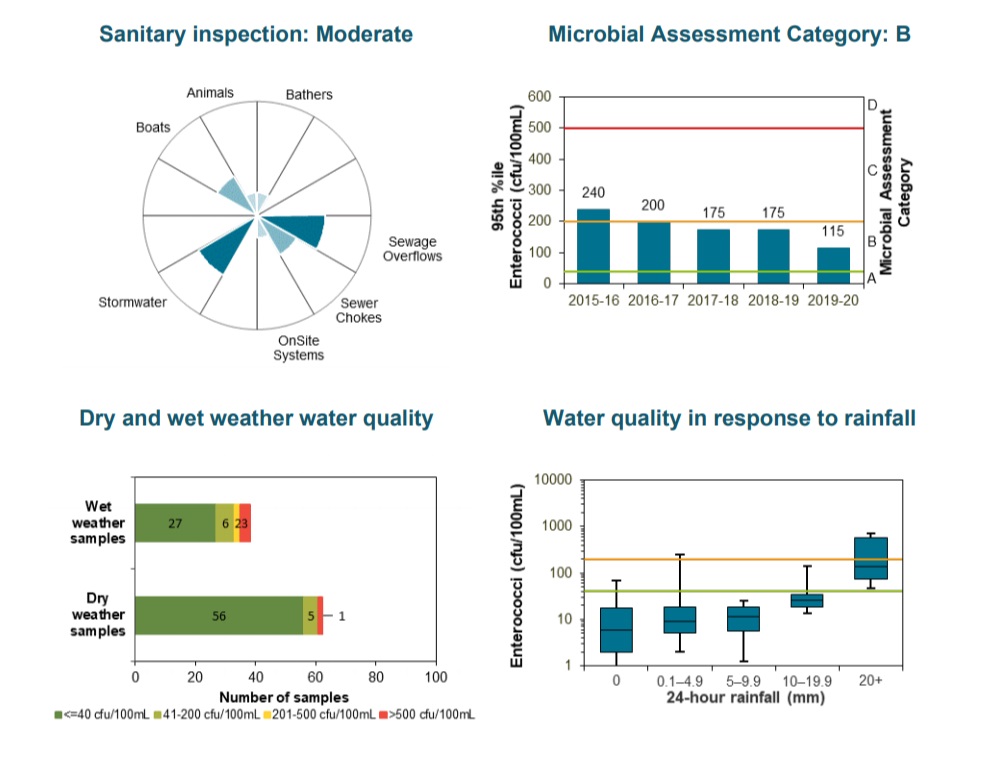
Elvina Bay
Elvina Bay is located on the south-western foreshore of Pittwater. The swimming area is not netted.
The Beach Suitability Grade of Very Good indicates microbial water quality is considered suitable for swimming almost all of the time, with few potential sources of significant faecal contamination.
Enterococci levels generally increased with increasing rainfall, occasionally exceeding the safe swimming limit after 10 mm or more of rain, and regularly after 20 mm or more.
The site has been monitored since 1995.
Assessment period Dry weather samples suitable for swimming Water samples Beach grade status
Oct 2017 to Mar 2020 100% 100 Improved
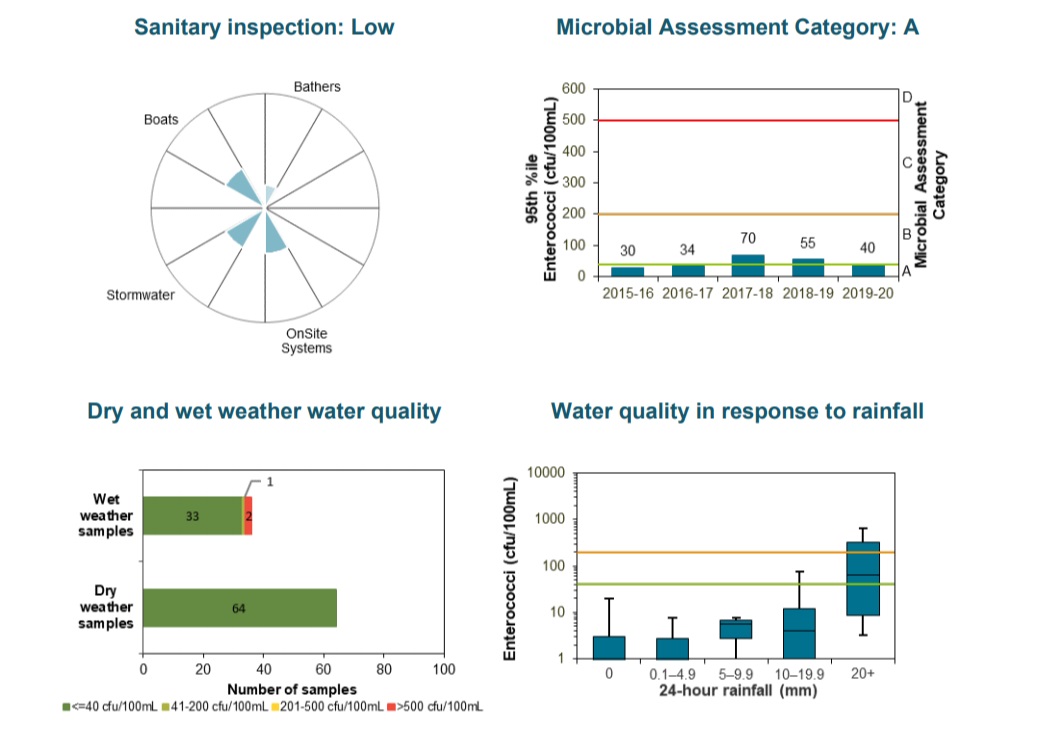
North Scotland Island
The North Scotland Island swimming site is a 15 by 50 metre netted enclosure located on the north side of Scotland Island in Pittwater.
The Beach Suitability Grade of Good indicates microbial water quality is considered suitable for swimming most of the time but may be susceptible to pollution after rain, with several potential sources of faecal contamination including onsite systems.
Enterococci levels generally increased with increasing rainfall, regularly exceeding the safe swimming limit after 20 mm or more.
The site has been monitored since 1995.
Assessment period Dry weather samples suitable for swimming Water samples Beach grade status
Oct 2017 to Mar 2020 100% 100 Stable
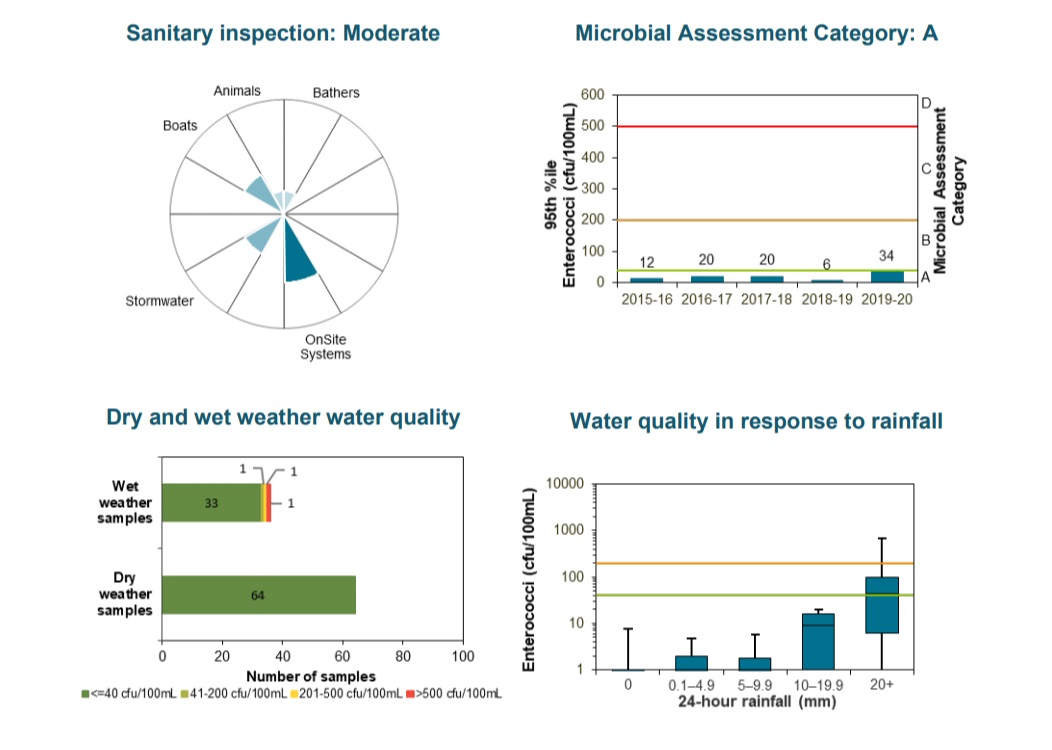
South Scotland Island
The South Scotland Island swimming site is located at Carols Wharf on the southern side of Scotland Island. The location is not netted and is backed by a reserve.
The Beach Suitability Grade of Good indicates microbial water quality is considered suitable for swimming most of the time but may be susceptible to pollution after rain, with several potential sources of faecal contamination including onsite systems.
Enterococci levels generally increased with increasing rainfall, regularly exceeding the safe swimming limit after 20 mm or more.
The site has been monitored since 1996.
Assessment period Dry weather samples suitable for swimming Water samples Beach grade status
Oct 2017 to Mar 2020 98% 100 Stable
The Basin
The Basin is a 500 metre sandy beach on the western side of Pittwater, backed by Ku-ring-gai Chase National Park.
The Beach Suitability Grade of Very Good indicates microbial water quality is considered suitable for swimming almost all of the time with few potential sources of significant faecal contamination.
Enterococci levels increased slightly with increasing rainfall, occasionally exceeding the safe swimming limit in response to 20 mm or more.
The site has been monitored since 1999.
Assessment period Dry weather samples suitable for swimming Water samples Beach grade status
Oct 2017 to Mar 2020 100% 100 Stable
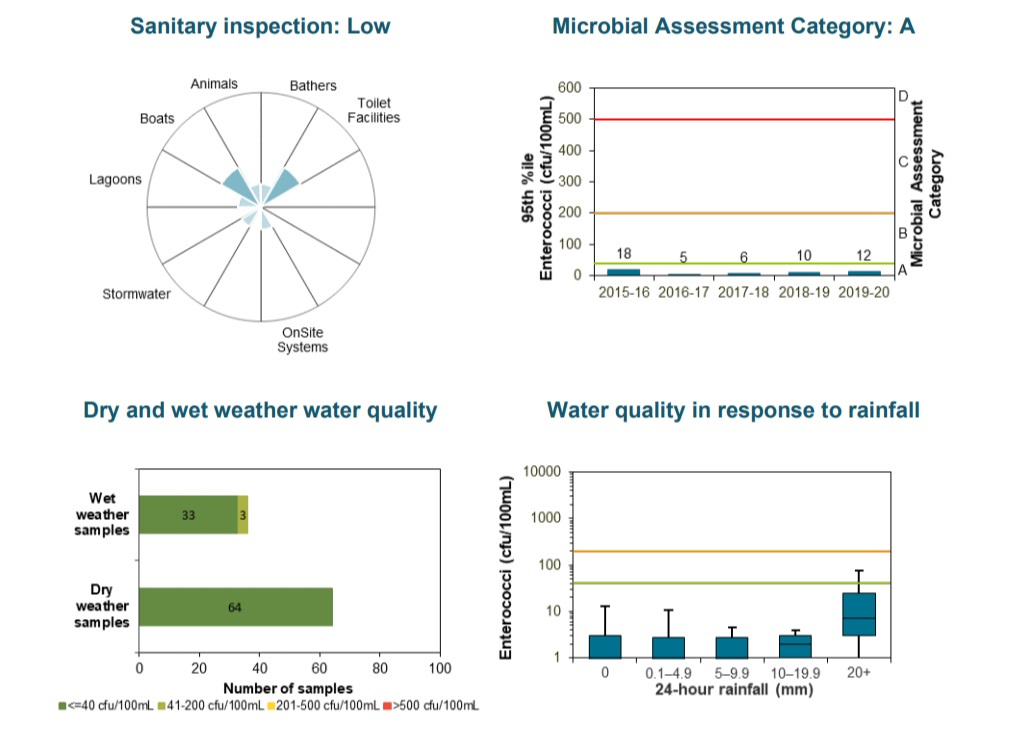
Great Mackerel Beach
Great Mackerel Beach is a 500 metre long sandy beach on the north-western side of Pittwater.
The Beach Suitability Grade of Very Good indicates microbial water quality is considered suitable for swimming almost all of the time with few potential sources of significant faecal contamination.
Enterococci levels increased slightly with increasing rainfall, occasionally exceeding the safe swimming limit in response to 20 mm or more.
The site has been monitored since 1999.
Assessment period Dry weather samples suitable for swimming Water samples Beach grade status
Oct 2017 to Mar 2020 100% 100 Stable
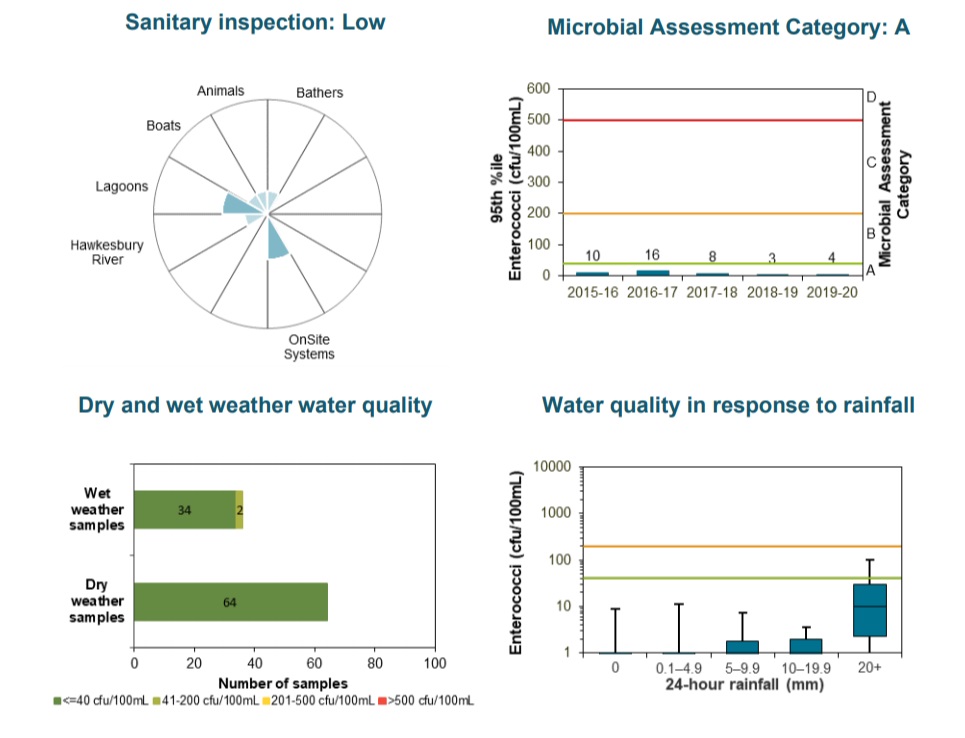
Pittwater's Ocean Beaches
Palm Beach
Palm Beach is 2.3 kilometres long, with rock baths in the southern corner. Lifeguards patrol the beach from September to April.
The Beach Suitability Grade of Very Good indicates microbial water quality is considered suitable for swimming almost all of the time, with few potential sources of faecal contamination.
Enterococci levels increased slightly with increasing rainfall, occasionally exceeding the safe swimming limit after 5 mm or more of rainfall.
The site has been monitored since 1989.
Assessment period Dry weather samples suitable for swimming Water samples Beach grade status
Jul 2018 to Apr 2020 97% 100 Stable
Whale Beach
Whale Beach is 600 metres long, with rock baths at the southern rock platform. Lifeguards patrol the beach from September to April.
The Beach Suitability Grade of Very Good indicates microbial water quality is considered suitable for swimming almost all of the time, with few potential sources of faecal contamination.
Enterococci levels increased slightly with increasing rainfall, but usually remained below the safe swimming limit across all rainfall categories.
The site has been monitored since 1989.
Assessment period Dry weather samples suitable for swimming Water samples Beach grade status
Jul 2018 to Apr 2020 97% 100 Stable
Avalon Beach
Avalon Beach is 500 metres long and backed by a park and picnic area. Lifeguards patrol the beach from September to April.
The Beach Suitability Grade of Very Good indicates microbial water quality is considered suitable for swimming almost all of the time, with few potential sources of faecal contamination.
Enterococci levels increased slightly with increasing rainfall, occasionally exceeding the safe swimming limit in response to 10 mm or more of rainfall.
The site has been monitored since 1989.
Assessment period Dry weather samples suitable for swimming Water samples Beach grade status
Jul 2018 to Apr 2020 97% 100 Stable
Bilgola Beach
Bilgola Beach is 500 metres long, with rock baths at the southern end. Lifeguards patrol the beach from September to April.
The Beach Suitability Grade of Very Good indicates microbial water quality is considered suitable for swimming almost all of the time, with few potential sources of faecal contamination.
Enterococci levels generally increased with increasing rainfall, occasionally exceeding the safe swimming limit after 5 mm or more of rain, and regularly after 20 mm or more.
The site has been monitored since 1989.
Assessment period Dry weather samples suitable for swimming Water samples Beach grade status
Jul 2018 to Apr 2020 100% 100 Stable
Newport Beach
Newport Beach is an open, east facing beach around 1.3 kilometres long. Lifeguards patrol the beach from September to April.
The Beach Suitability Grade of Very Good indicates microbial water quality is considered suitable for swimming almost all of the time, with few potential sources of significant faecal contamination.
Enterococci levels generally increased with increasing rainfall, occasionally exceeding the safe swimming limit after light rain, and often after 20 mm or more.
The site has been monitored since 1989.
Assessment period Dry weather samples suitable for swimming Water samples Beach grade status
Jul 2018 to Apr 2020 97% 100 Stable
Bungan Beach
Bungan Beach is 600 metres long and backed by a steep escarpment. Lifeguards patrol the beach from late December to the end of January.
The Beach Suitability Grade of Very Good indicates microbial water quality is considered suitable for swimming almost all of the time, with few potential sources of significant faecal contamination.
Enterococci levels increased slightly with increasing rainfall, often exceeding the safe swimming limit in response to 20 mm or more of rainfall.
The site has been monitored since 1989.
Assessment period Dry weather samples suitable for swimming Water samples Beach grade status
Jul 2018 to Apr 2020 97% 100 Stable
Mona Vale Beach
Mona Vale Beach is one kilometre long. Lifeguards patrol the beach from September to April.
The Beach Suitability Grade of Good indicates microbial water quality is considered suitable for swimming most of the time but can be susceptible to pollution after rain, with several potential sources of minor faecal contamination.
Enterococci levels generally increased with increasing rainfall, occasionally exceeding the safe swimming limit after light rain, and often after 20 mm or more.
The site has been monitored since 1989.
Assessment period Dry weather samples suitable for swimming Water samples Beach grade status
Jul 2018 to Apr 2020 99% 100 Declined
Warriewood Beach
Warriewood Beach is 500 metres long and located below a steep bluff. The beach is patrolled during holiday periods.
The Beach Suitability Grade of Good indicates microbial water quality is considered suitable for swimming most of the time but can be susceptible to pollution after rain, with several potential sources of faecal contamination including Warriewood Wastewater Treatment Plant (WWTP).
Enterococci levels generally increased with increasing rainfall, often exceeding the safe swimming limit after 20 mm or more of rainfall.
The site has been monitored since 1989.
Assessment period Dry weather samples suitable for swimming Water samples Beach grade status
Jul 2018 to Apr 2020 96% 100 Stable
Turimetta Beach
Turimetta Beach is 350 metres long and is backed by steep bluffs. This beach is not patrolled by lifeguards.
The Beach Suitability Grade of Good indicates microbial water quality is considered suitable for swimming most of the time but may be susceptible to pollution after rain, with several potential sources of faecal contamination including Warriewood WWTP.
Enterococci levels increased slightly with increasing rainfall, occasionally exceeding the safe swimming limit after rainfall.
The site has been monitored since 1994.
Assessment period Dry weather samples suitable for swimming Water samples Beach grade status
Jul 2018 to Apr 2020 99% 100 Stable
North Narrabeen Beach
North Narrabeen Beach is located at the northern end of the 3.5 kilometre-long beach and is patrolled from September to April.
The Beach Suitability Grade of Good indicates microbial water quality is considered suitable for swimming most of the time but may be susceptible to pollution after rain, with several potential sources of faecal contamination including discharge from Narrabeen Lagoon.
Enterococci levels increased with increasing rainfall, occasionally exceeding the safe swimming limit in response to light rain, and often after 10 mm or more.
The site has been monitored since 1989.
Assessment period Dry weather samples suitable for swimming Water samples Beach grade status
Jul 2018 to Apr 2020 96% 100 Stable
Narrabeen Lagoon (Birdwood Park)
The Birdwood Park swimming site is a sandy beach on the southern side of the entrance to Narrabeen Lagoon. The lagoon entrance has been periodically open and closed at times.
The Beach Suitability Grade of Good indicates microbial water quality is considered suitable for swimming most of the time but can be susceptible to pollution after rain, with several potential sources of faecal contamination including the lagoon itself.
Enterococci levels increased with increasing rainfall, occasionally exceeding the safe swimming limit after no rain, and often after rainfall.
The site has been monitored since 2004.
Assessment period Dry weather samples suitable for swimming Water samples Beach grade status
Jul 2018 to Apr 2020 86% 100 Stable
Bilarong Reserve
Bilarong Reserve is located on the northern shoreline of Narrabeen Lagoon.
The Beach Suitability Grade of Good indicates microbial water quality is considered suitable for swimming most of the time but can be susceptible to pollution after rain, with several potential sources of faecal contamination including the lagoon itself.
Enterococci levels generally increased with increasing rainfall, occasionally exceeding the safe swimming limit in response to little or no rain, and regularly after 5 mm or more.
The site has been monitored since 2014.
Assessment period Dry weather samples suitable for swimming Water samples Beach grade status
Jul 2018 to Apr 2020 82% 100 Improved
Collaroy To Manly Ocean Beaches
Collaroy Beach
Collaroy Beach is backed by a park and picnic area. Lifeguards patrol the beach from September to April.
The Beach Suitability Grade of Good indicates microbial water quality is considered suitable for swimming most of the time but may be susceptible to pollution after rain, with several potential sources of faecal contamination including stormwater.
Enterococci levels increased with increasing rainfall, occasionally exceeding the safe swimming limit after light rain and often after 5 mm or more.
The site has been monitored since 1989.
Assessment period Dry weather samples suitable for swimming Water samples Beach grade status
Jul 2018 to Apr 2020 99% 100 Stable
Long Reef Beach
Long Reef Beach is located near the entrance of Dee Why Lagoon. Lifeguards patrol the beach from September to April.
The Beach Suitability Grade of Good indicates microbial water quality is considered suitable for swimming most of the time but may be susceptible to pollution after rain, with potential faecal contamination from discharge from Dee Why Lagoon.
Enterococci levels generally increased with increasing rainfall, occasionally exceeding the safe swimming limit after 5 mm or more of rain, and often after 20 mm or more.
The site has been monitored since 1989.
Assessment period Dry weather samples suitable for swimming Water samples Beach grade status
Jul 2018 to Apr 2020 96% 100 Stable
Dee Why Beach
Dee Why Beach is located at the southern end of the stretch of beach and is patrolled by lifeguards from late August to May.
The Beach Suitability Grade of Very Good indicates microbial water quality is considered suitable for swimming almost all of the time, with few potential sources of significant faecal contamination.
Enterococci levels increased slightly with increasing rainfall, occasionally exceeding the safe swimming limit in response to 5 mm or more of rain and often after 20 mm or more.
The site has been monitored since 1989.
Assessment period Dry weather samples suitable for swimming Water samples Beach grade status
Jul 2018 to Apr 2020 96% 100 Stable
North Curl Curl Beach
North Curl Curl Beach is located near the entrance to Curl Curl Lagoon. Lifeguards patrol the beach from September to April.
The Beach Suitability Grade of Good indicates microbial water quality is considered suitable for swimming most of the time but may be susceptible to pollution after rain, with several potential sources of faecal contamination including discharge from Curl Curl Lagoon.
Enterococci levels increased with increasing rainfall, often exceeding the safe swimming limit after 5 mm or more of rain and frequently after 20 mm or more.
The site has been monitored since 1989.
Assessment period Dry weather samples suitable for swimming Water samples Beach grade status
Jul 2018 to Apr 2020 97% 100 Stable
South Curl Curl Beach
South Curl Curl Beach is at the southern end of Curl Curl Beach and is patrolled by lifeguards from September to April.
The Beach Suitability Grade of Very Good indicates microbial water quality is considered suitable for swimming almost all of the time, with few potential sources of faecal contamination.
Enterococci levels increased slightly with increasing rainfall, occasionally exceeding the safe swimming limit in response to 10 mm or more of rain, and often after 20 mm or more.
The site has been monitored since 1989.
Assessment period Dry weather samples suitable for swimming Water samples Beach grade status
Jul 2018 to Apr 2020 95% 100 Stable
Freshwater Beach
Freshwater Beach is approximately 350 metres long and is patrolled by lifeguards from late August to May.
The Beach Suitability Grade of Good indicates microbial water quality is considered suitable for swimming most of the time but may be susceptible to pollution after rain, with several potential sources of faecal contamination including stormwater.
Enterococci levels generally increased with increasing rainfall, occasionally exceeding the safe swimming limit after 5 mm or more of rain, and frequently after 20 mm or more.
The site has been monitored since 1989.
Assessment period Dry weather samples suitable for swimming Water samples Beach grade status
Jul 2018 to Apr 2020 96% 100 Stable
Queenscliff Beach
Queenscliff Beach is located at the northern end of Manly Beach. Lifeguards patrol the beach from September to April.
The Beach Suitability Grade of Good indicates microbial water quality is considered suitable for swimming most of the time but may be susceptible to pollution after rain, with several potential sources of faecal contamination, including discharge from Manly Lagoon.
Enterococci levels increased with increasing rainfall, occasionally exceeding the safe swimming limit after light rain, and often after 5 mm or more.
The site has been monitored since 1989.
Assessment period Dry weather samples suitable for swimming Water samples Beach grade status
Jul 2018 to Apr 2020 96% 100 Stable
North Steyne Beach
North Steyne Beach is the middle section of Manly Beach. Lifeguards patrol the beach from September to April.
The Beach Suitability Grade of Good indicates microbial water quality is considered suitable for swimming most of the time but may be susceptible to pollution after rain, with several potential sources of faecal contamination including stormwater and discharge from Manly Lagoon.
Enterococci levels generally increased with increasing rainfall, occasionally exceeding the safe swimming limit after 5 mm or more of rain, and often after 10 mm or more.
The site has been monitored since 1989.
Assessment period Dry weather samples suitable for swimming Water samples Beach grade status
Jul 2018 to Apr 2020 97% 100 Stable
South Steyne Beach
South Steyne Beach is at the southern end of Manly Beach. Lifeguards patrol the beach year round.
The Beach Suitability Grade of Good indicates microbial water quality is considered suitable for swimming most of the time but may be susceptible to pollution after rain, with several potential sources of faecal contamination including stormwater.
Enterococci levels increased with increasing rainfall, occasionally exceeding the safe swimming limit after no rain and often after 10 mm or more.
The site has been monitored since 1989.
Assessment period Dry weather samples suitable for swimming Water samples Beach grade status
Jul 2018 to Apr 2020 94% 100 Stable
Shelly Beach
Shelly Beach is backed by a picnic area and reserve and is not patrolled by lifeguards.
The Beach Suitability Grade of Good indicates microbial water quality is considered suitable for swimming most of the time, but may be susceptible to pollution after rain, with several potential sources of minor faecal contamination.
Enterococci levels increased with increasing rainfall, occasionally exceeding the safe swimming limit after light rain, and often after 5 mm or more.
The site has been monitored since 1989.
Assessment period Dry weather samples suitable for swimming Water samples Beach grade status
Jul 2018 to Apr 2020 94% 100 Declined